The following article was first published in the Philatelic Journal of Great Britain (March, 1936) and was written by S. H. CREESE from a paper read before the Manchester Philatelic Society.
THE convenient classification of the Postmarks of the Falkland Islands is as follows:
I. “Cork” Cancellations.
II. “F.I.” Obliteration.
III. Circular Postmarks.
IV. Ship Cancellations.
V. The Postmarks used in the Dependencies.
Type 1. “Cork” Cancellation.
The “Cork” cancellation, as is well known, received its name from the fact that the cancelling stamp was made from a cork by cutting nicks out of the face. No set pattern was aimed at and there is consequently some variety of shape and size. In some case the “cuts” are quite small and more or less uniform in size, while in others they are as much as seven or eight times as large and anything but uniform. The number of cuts varies from about four to twenty.
The “Cork ” was at one time supposed to have been largely used for parcels, and as the stamps would in that case have been removed from the covering, it is not easy to disprove the statement, but there is plenty of evidence to show that it was used very freely on letters also. It is a more common obliteration on covers franked by the “bisects” than any other, though in this case it is usually (I think, probably, always) accompanied by the circular mark, Type III C(i). As stamps of the first issue are commonly found “corked”, it may be fair to assume that it was in use from 1878 to about 1895, or perhaps a little later. I have evidence as late as 28th December, 1893.
Type II. “F.I.” Obliterator
This was used concurrently with Type I. In my experience it is the usual one to be found on the 1d. and 6d. of the first issue and it is met with, though less frequently, on the stamps of the 1891-1904 set. I think it was probably put out of commission at the same time as the “Cork.” It consists of the letters “F.I.” in capitals enclosed by two short thin curved lines at each side, and, above and below, three thick bars. It takes the shape of an upright oval which, from vertex to vertex, measures 26mm., the greatest breadth being l9mm.
A variation of this postmark is also found consisting of the same letters but framed on each side by one, sometimes two, thick straight bars. The appearance of both letters and bars and the fact that they vary in shape and size make it obvious that they have been cut by hand, a combination of “Cork ” and ” F.I.” being the result. These are distinctly scarce and worth looking for.
Type III. Circular Postmarks
These postmarks always consist of two concentric circles, but they vary in size and I classify them accordingly A, B, and C.
A. Oute circle, diameter 25-26mm., Inner circle, 18mm.
B. Outer circle, diameter 28mm., Inner circle 17mm.
C. Outer circle, diameter 25-26mm., Inner circle 16mm.
A. is, I think, scarcer than the “Cork” or “F.I.”, though not the rarest of the circular postmarks. There is proof, that it was in use before the issue of adhesive stamps as it is found on the franked covers, and it was almost certainly the first type of postmark to be used in the Colony. The latest date I know of is 24th January, 1900.
The odd thing is that the year, a nineteenth century one, is always given in full (four figures), whereas I have yet to find a twentieth century date showing more than the last two figures of the year. This seems noteworthy, even if quite unimportant, as illustrating the tendency of the century to save time and trouble whenever possible!
B: There are two varieties of this class.
B(i) is, I think, without doubt the scarcest postinark of this Colony. It consists of the two words “FALKLAND ISLANDS” with a dot between them at each side, but in the word “ISLANDS” there has been mysteriously inserted an apostrophe. The apostrophe postmark is well known, but this example of it is not the one usually found. The commoner one is referred to later. The larger size and the fact that the apostrophe would so often fall on the envelope and not on the stamp make this example more difficult to identify on Ioose specimens, and accounts for so many collectors of this country being ignorant of its existence. (Known date as illustrated).
B(ii) is similar to the last but without the apostrophe, and crosses take the place of the dots between the words. This cancellation has been used on the stamps of the first three reigns, but as it never, so far as I know, has the date of the year in full, I think it must date from 1901. (In use 17th September, 1901 to present day.)
C. Under this heading we find six varieties.
C(i) is the well-known apostrophe postmark, is well known, but this example of it is not which, of course, cannot be mistaken for Type III B(i) because of the difference in size. It is fairly common, and is frequently found acting as a date stamp in conjunction with cancellation by Types I or II, especially on covers franked by the “‘bisects.” Both apostrophe types appear to have been used chiefly in the last decade of the nineteenth century and to have gone out of use at the end of it.
C(ii) and C(iii) are very similar and call for little comment, though I do not consider the former common. I have not seen any recent covers bearing either of these cancellations.
C(iv) gives us the first example of the name of a town included in the postmark, PORT STANLEY, the capital, and only town, received this distinction some twenty years ago. The cancellation is found on the stamps of King Edward VII, but probably only because those of the next reign were not issued till 1912. (In use 27th September, 1913 to present day.)
C(v). FOX BAY followed Stanley and like the latter is to be found occasionally on the Edward VII set. This settlement is in West Falkland, one of the two main islands of the group. (In use 1914 to present day.) The postmark is similar to Type III. C(ii). The words “FOX-BAY” are above and “FALKLAND ISLANDS” below.
I have an interesting cover, addressed to a business firm in Manchester, bearing a pair of S.G. 69 cancelled in manuscript in ordinary ink “24/7/30” across the pair and “Fox Bay” across each stamp, and tied. There is no postmark at all on the envelope.
C(vi). NEW ISLAND, which lies off the west coast of West Falkland, had a special postmark in use during the time that a Post Office was open there. This is said to have been from August, 1909 to October, 1914. These dates have been quoted by Mr. B. S. H. Grant as official, but in that excellent book “The Falkland Islands” by V. F. Boyson (Clarendon Press), the author states, page 225, that “the first whaling factory erected at the Falkland Islands was that on New Island by the British firm of Messrs. Salvesen and Co., in 1908-09”, and later, pane 226, “No whaling operations have been carried on at the Falklands themselves since March 1916, when Messrs. Salvesen’s station at New Island was removed to South Georgia.” The first of these dates corresponds with the date of opening given by Mr. Grant, but, if the date of Salvesen’s removal is correct, it seems odd that the Post Office should have been closed seventeen months before, as the reason for its existence is obvious. Copies are known dated 22nd November, 1915, and other dates, but these have been regarded as having been done by favour. The postmark is similar to Type III, C(ii). The words “NEW ISLAND” and above and “FALKLAND IS.” below.
Type IV. Ship Cancellations
A. “AFTERGLOW” – This cancellation is well known. The “Afterglow,” a patrol vessel employed to protect the seal fisheries, is not now in commission and specimens are scarce. It was discontinued in 1926. Copies seen dated 6th November, 1923 to 24th March, 1926. This is certainly one of the most attractive Ship cancellations to be found anywhere.
B. “POSTED ON BOARD” – A cancellation applied in black or violet ink, and similar in size and shape to that of “Afterglow.” In between the lines of the double oval occur the words “Posted on Board” and the name of the vessel. This latter has been cut away Ieaving only a series of indecipherable marks. The earliest date I have seen is 20th September, 1914, and the latest 8th November, 1918. These both occur during the War period, and I think that the cutting away of the name was a war measure utilised for official reasons. Copies also exist without date. The dated copy referred to (November) shows that a second and separate handstarnp has been applied, reading “R.M.S. Falkland,” in a straight line lengthways across the oval cancellation.
Type V. The Postmarks Used in the Dependencies
SOUTH GEORGIA – There is a Post Office open all the year round at Grytviken, this dating from 3rd December, 1909. No special cancelling stamp was issued at first, the ordinary postmark, Type III B(ii), being used in conjunction with the famous handstamp “South Georgia” applied below the stamp. I have a cover from the Dependency bearing this combination and dated 23rd May, 1910, addressed to the Falkland Islands, and backstamped there 2nd June, 1910, Type III C(ii). This is proof that cancelling was done at South Georgia, at any rate at that time, and not, as has been stated, at Stanley on arrival of the mail.
A(i). The first distinctive South Georgia postmark appeared in July, 1910. The outer circle is 27mm in diameter, inner, 16mm. Similar to Type III. C(ii). The word “SOUTH” is above and “GEORGIA” below.
A(ii) followed shortly after, the earliest date I can give being 1914, and this and the foregoing have been used concurrently. I have examples of both used on the same day, 7th December, 1933, and both were in use until quite recently, but a new one has now appeared and may have superseded them. Similar to Type III, C(iii).
A(iii). This is interesting and I believe it to be the first example of time stamping to come from the Colony. It is slightly larger than the normal, the outer circle being a full 26mm., inner 16mm. Mail despatched from Port Stanley on 31st December, 1935, failed to show any time stamp, and it looks as though South Georgia is one up on the capital. (Earliest date seen: as illustrated.)
SOUTH SHETLANDS. B(i). In 1914 an oval rubber date stamp was use to cancel stamps in this Dependency; it bore the words “Deception Island, South Shetlands,” with the date in a straight line across the inner oval. This was in use for a period of ten years to 1924. It is only in the whaling season (October-April) that mails are handled and the quantitymust be very moderate. Covers are comparatively scarce and the existence of the majority of them has probably been caused by the demands of collectors.
B(ii). In 1924 the circular South Shetlands postmark was substituted for the oval date stamp and this is now in use. No registration facilities exist and such correspondence usually bears the Stanley registration label, though I have a cover from the South Shetlands (dated 15th March, 1929) which has been registered at South Georgia. Similar to Type III, C(iii).
And here ends the list of the various postmarks of the Falkland Islands, but this account does not pretend to be the last word on the subject. AII dates quoted are known to me, on specimens either in my collection, or which I have seen; but there must be many who can add to the information given here and communications from collectors interested would be very welcome.


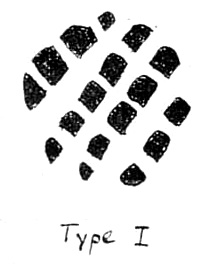
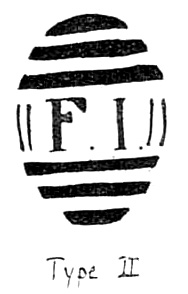
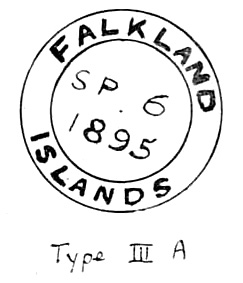



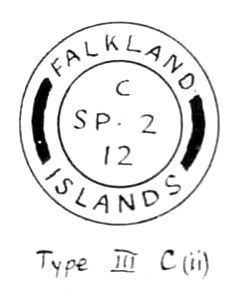
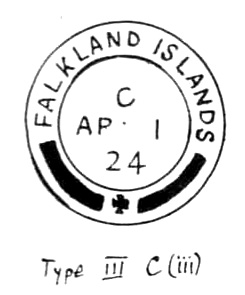

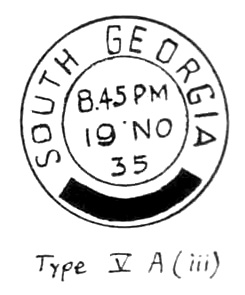





Incredibly useful….look forwards to returning.